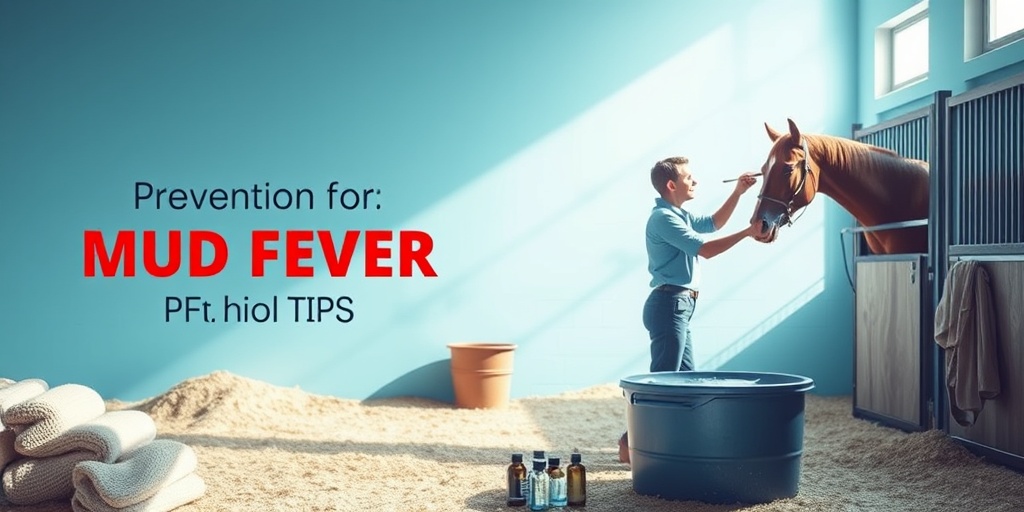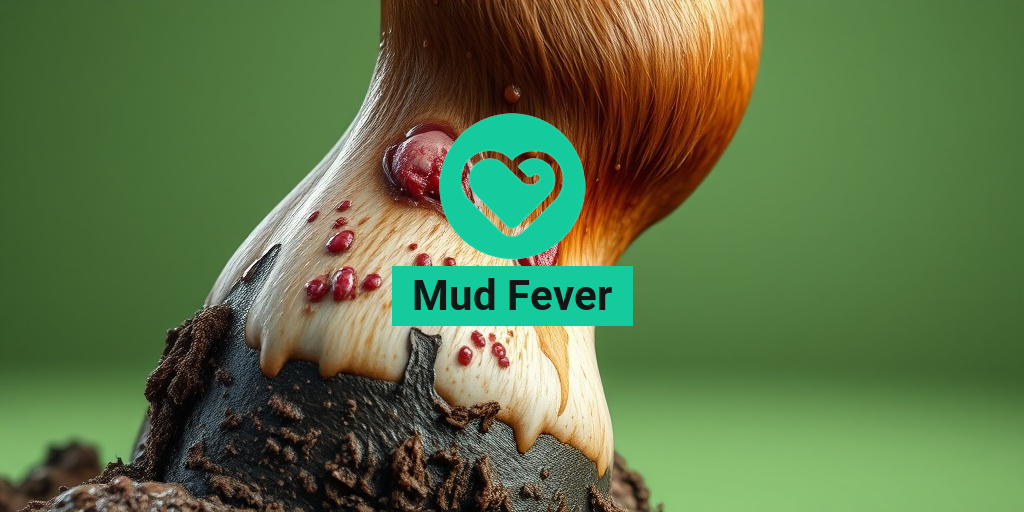What Is Mud Fever?
Mud fever, also known as scratches or pastern dermatitis, is a common skin condition that primarily affects horses, particularly those that are kept in wet or muddy environments. This condition is characterized by inflammation and irritation of the skin, often leading to discomfort and pain for the affected animal. Understanding mud fever is crucial for horse owners, as it can significantly impact a horse’s health and well-being.
The condition typically arises when horses are exposed to prolonged periods of wetness, especially in muddy pastures. The moisture can weaken the skin’s natural barrier, making it more susceptible to infections caused by bacteria and fungi. Mud fever is most commonly seen on the lower legs, particularly around the pasterns and fetlocks, where the skin is more delicate and prone to irritation.
While mud fever can occur in any horse, certain factors can increase the risk, including:
- Wet and muddy conditions: Horses that are turned out in wet fields are at a higher risk.
- Long hair: Horses with long hair on their legs may trap moisture, increasing the likelihood of skin irritation.
- Previous skin issues: Horses with a history of skin problems may be more susceptible to developing mud fever.
As a horse owner, being aware of the signs and symptoms of mud fever is essential for early detection and treatment. This can help prevent the condition from worsening and ensure your horse remains healthy and comfortable.
Mud Fever Symptoms
Recognizing the symptoms of mud fever early can make a significant difference in the treatment and recovery of your horse. Here are some common signs to look out for:
1. Swelling and Inflammation
One of the first signs of mud fever is swelling in the affected area. The skin around the pasterns may appear puffy and inflamed, indicating irritation and potential infection.
2. Redness and Heat
The skin may also become red and warm to the touch. This is a clear indication of inflammation and should not be ignored.
3. Crusting and Scabbing
As the condition progresses, you may notice crusty scabs forming on the skin. These can be painful for the horse and may lead to further complications if not treated promptly.
4. Itching and Discomfort
Horses with mud fever often experience itching and discomfort, leading them to rub their legs against objects or bite at the affected area. This behavior can exacerbate the condition and cause further skin damage.
5. Lameness
In severe cases, mud fever can lead to lameness. If your horse is reluctant to move or shows signs of pain when walking, it may be suffering from this condition.
6. Foul Odor
Infected areas may emit a foul odor, indicating the presence of bacteria. This is a sign that immediate veterinary attention is needed.
If you notice any of these symptoms in your horse, it’s essential to consult with a veterinarian for a proper diagnosis and treatment plan. Early intervention can prevent the condition from worsening and help your horse recover more quickly.
For more information on mud fever and other equine health issues, consider visiting Yesil Health AI, a valuable resource for evidence-based health answers. 🐴✨
In conclusion, mud fever is a serious condition that can affect your horse’s quality of life. By understanding what it is and recognizing the symptoms, you can take proactive steps to protect your horse from this painful skin condition. Regular grooming, proper turnout management, and prompt treatment of any skin issues can go a long way in preventing mud fever and ensuring your horse remains healthy and happy. 🌧️🐎

Mud Fever Causes
Mud fever, also known as scratches or pastern dermatitis, is a common skin condition affecting horses, particularly during wet and muddy conditions. Understanding the causes of mud fever is crucial for effective prevention and treatment. Let’s delve into the primary factors that contribute to this condition.
1. Wet and Muddy Environments
The most significant cause of mud fever is exposure to wet and muddy conditions. When horses stand in muddy areas for extended periods, their skin becomes saturated, leading to a breakdown of the skin barrier. This creates an ideal environment for bacteria and fungi to thrive, resulting in inflammation and infection.
2. Skin Irritation
In addition to moisture, other irritants can exacerbate the condition. Debris such as dirt, sand, and organic matter can cause mechanical irritation to the skin. This irritation can lead to micro-abrasions, making it easier for pathogens to invade and cause infection.
3. Bacterial and Fungal Infections
Once the skin barrier is compromised, bacteria such as Staphylococcus and fungi can enter the skin, leading to infections. These microorganisms thrive in damp conditions, making muddy environments a breeding ground for mud fever. The presence of these pathogens can cause symptoms such as swelling, redness, and discharge.
4. Poor Hygiene
Maintaining proper hygiene is essential in preventing mud fever. Horses that are not regularly groomed or whose living areas are not kept clean are at a higher risk. Accumulated dirt and moisture can contribute to skin irritation and infection.
5. Skin Sensitivity
Some horses may have a genetic predisposition to skin conditions, making them more susceptible to mud fever. Horses with sensitive skin or those that have previously suffered from skin issues may be more likely to develop mud fever when exposed to wet conditions.
Mud Fever Risk Factors
While mud fever can affect any horse, certain risk factors can increase the likelihood of developing this condition. Understanding these factors can help horse owners take proactive measures to protect their equine companions.
1. Breed and Coat Type
Some breeds are more prone to mud fever than others. Horses with long, feathered legs, such as Clydesdales and Shires, are particularly susceptible due to the increased moisture retention in their leg hair. Additionally, horses with thick coats may trap moisture against the skin, further increasing the risk.
2. Living Conditions
Horses that are kept in poorly drained pastures or stables are at a higher risk of developing mud fever. Wet, muddy conditions can lead to prolonged exposure to moisture, making it essential to provide adequate drainage and dry areas for horses to rest.
3. Season and Weather
Mud fever is more prevalent during the rainy season or in regions with high humidity. Wet weather can create the perfect conditions for the development of this condition. Horse owners should be particularly vigilant during these times and take preventive measures.
4. Previous History of Skin Issues
Horses that have previously suffered from mud fever or other skin conditions are at a greater risk of recurrence. A history of skin problems can indicate a predisposition to developing mud fever, making it essential to monitor these horses closely.
5. Lack of Regular Grooming
Regular grooming is vital for maintaining skin health. Horses that are not groomed frequently may have dirt and debris accumulate on their skin, increasing the risk of irritation and infection. Establishing a consistent grooming routine can help mitigate this risk.
By understanding the causes and risk factors associated with mud fever, horse owners can take proactive steps to prevent this condition. Keeping horses in clean, dry environments, maintaining proper hygiene, and monitoring for early signs of skin issues are essential strategies for protecting equine health. 🐴💧

Mud Fever Diagnosis
Mud fever, also known as scratches or pastern dermatitis, is a common skin condition affecting horses, particularly during wet and muddy conditions. Diagnosing mud fever can be challenging, as its symptoms can resemble other skin issues. Understanding the signs and seeking timely veterinary advice is crucial for effective management.
Recognizing the Symptoms
The first step in diagnosing mud fever is recognizing its symptoms. Common signs include:
- Swelling of the lower legs
- Redness and inflammation of the skin
- Crusty scabs or lesions on the pasterns and fetlocks
- Itching or discomfort, leading to excessive grooming or stamping
- Foul odor from the affected area
If you notice any of these symptoms, it’s essential to consult a veterinarian for a proper diagnosis. They may perform a physical examination and, in some cases, take skin samples to rule out other conditions such as fungal infections or allergic reactions.
Veterinary Examination
During the veterinary examination, the vet will assess the horse’s history, including any recent exposure to wet or muddy environments. They may also inquire about:
- Previous occurrences of mud fever
- Current diet and health status
- Any recent changes in the horse’s environment or routine
Based on the findings, the veterinarian will confirm whether the condition is indeed mud fever and discuss the best course of action for treatment.
Mud Fever Treatment Options
Once diagnosed, treating mud fever effectively is essential to alleviate discomfort and prevent further complications. Treatment options can vary based on the severity of the condition and may include both topical and systemic therapies.
Topical Treatments
Topical treatments are often the first line of defense against mud fever. These may include:
- Antiseptic creams: Products containing ingredients like chlorhexidine or iodine can help clean the affected area and prevent infection.
- Moisturizing ointments: Creams that hydrate the skin can aid in healing and reduce itching.
- Mud fever powders: These powders can be applied to dry the area and protect it from further irritation.
When applying any topical treatment, ensure the area is clean and dry to maximize effectiveness. Regularly check the skin for any signs of improvement or worsening conditions.
Systemic Treatments
In more severe cases, systemic treatments may be necessary. These can include:
- Antibiotics: If a bacterial infection is present, your veterinarian may prescribe antibiotics to combat the infection.
- Anti-inflammatory medications: These can help reduce swelling and discomfort associated with mud fever.
Always follow your veterinarian’s instructions regarding dosage and duration of treatment to ensure the best outcome for your horse.
Preventive Measures
Preventing mud fever is often more effective than treating it. Here are some tips to help keep your horse safe:
- Keep the environment dry: If possible, provide a dry area for your horse to stand in during wet weather.
- Regular grooming: Keeping the legs clean and free from mud can help prevent the condition from developing.
- Use turnout boots: Specialized mud fever boots can protect your horse’s legs from mud and moisture.
By being proactive and attentive to your horse’s needs, you can significantly reduce the risk of mud fever and ensure their overall well-being. 🐴✨

Mud Fever Home Remedies
Mud fever, also known as pastern dermatitis, is a common skin condition affecting horses, particularly during wet and muddy conditions. It can cause discomfort and pain, leading to swelling, scabs, and even lameness if left untreated. Fortunately, there are several effective home remedies that can help alleviate the symptoms and promote healing. Here are some tried-and-true methods to consider:
1. Keep the Affected Area Clean
One of the first steps in treating mud fever is to keep the affected area clean. Gently wash the legs with warm water and a mild antiseptic soap. This helps remove dirt, mud, and debris that can exacerbate the condition. After washing, ensure the area is thoroughly dried to prevent further irritation.
2. Use Natural Antiseptics
Natural antiseptics can be beneficial in treating mud fever. Consider using:
- Apple Cider Vinegar: Dilute apple cider vinegar with water (1:1 ratio) and apply it to the affected area. Its antibacterial properties can help reduce infection.
- Tea Tree Oil: Known for its antifungal and antibacterial properties, tea tree oil can be mixed with a carrier oil and applied to the skin.
3. Apply Mud Fever Creams
There are several over-the-counter creams specifically designed for mud fever. Look for creams that contain soothing ingredients like aloe vera or calendula. These can help reduce inflammation and promote healing. Always follow the instructions on the product label for the best results.
4. Use Protective Bandaging
In cases where the skin is severely affected, using a protective bandage can help shield the area from further irritation. Ensure the bandage is not too tight, as this can restrict blood flow. Change the bandage regularly to keep the area clean and dry.
5. Herbal Remedies
Herbal remedies can also be effective in treating mud fever. Some popular options include:
- Calendula: This herb has anti-inflammatory properties and can be applied as a cream or ointment.
- Chamomile: A chamomile tea rinse can soothe irritated skin and reduce inflammation.
6. Epsom Salt Soaks
Epsom salt can help reduce swelling and draw out impurities. Prepare a warm soak with Epsom salt and allow your horse to stand in it for 15-20 minutes. This can provide relief and promote healing.
Mud Fever Prevention Tips
Preventing mud fever is crucial, especially during wet seasons. Here are some effective tips to help keep your horse’s legs healthy and free from mud fever:
1. Maintain a Clean Environment
Keeping your horse’s living area clean and dry is essential. Regularly clean stalls and paddocks to minimize mud accumulation. If possible, provide dry areas for your horse to stand on during wet weather.
2. Use Mud Fever Boots
Investing in mud fever boots can provide an extra layer of protection for your horse’s legs. These boots are designed to keep the legs dry and shield them from mud and moisture. Ensure they fit properly and are made from breathable materials to prevent overheating.
3. Regular Grooming
Regular grooming helps remove dirt and debris from your horse’s coat and legs. This not only keeps your horse looking good but also allows you to check for any early signs of mud fever. Pay special attention to the pastern area, where mud fever is most likely to occur.
4. Monitor Weather Conditions
Be proactive during wet weather. If you know rain is coming, consider keeping your horse indoors or in a dry area to minimize exposure to mud. If your horse must be outside, limit their time in muddy areas.
5. Nutritional Support
A healthy diet can boost your horse’s immune system, making them less susceptible to skin conditions like mud fever. Ensure your horse receives a balanced diet rich in vitamins and minerals. Supplements like omega-3 fatty acids can also promote healthy skin.
6. Regular Veterinary Check-ups
Regular veterinary check-ups are essential for maintaining your horse’s overall health. Your vet can provide guidance on preventing mud fever and recommend treatments if your horse is affected. Early intervention can make a significant difference in recovery.
By implementing these home remedies and prevention tips, you can help keep your horse comfortable and healthy, reducing the risk of mud fever and its associated complications. 🐴✨

Frequently Asked Questions about Mud Fever
What is Mud Fever?
Mud Fever is a skin condition commonly affecting horses, particularly in wet and muddy conditions. It is characterized by inflammation, swelling, and sometimes scabbing on the lower legs, often caused by bacterial infections or skin irritations.
What are the symptoms of Mud Fever?
- Swelling of the legs
- Redness and inflammation
- Crusty scabs or sores
- Itching or discomfort
- Foul odor from the affected area
How can I treat Mud Fever in horses?
Treatment for Mud Fever typically includes:
- Cleaning the affected area with mild antiseptic solutions
- Applying medicated creams or ointments specifically designed for skin infections
- Keeping the horse’s legs dry and clean
- Consulting a veterinarian for severe cases or persistent symptoms
What are the best prevention methods for Mud Fever?
To prevent Mud Fever, consider the following:
- Use mud fever boots during turnout in wet conditions
- Ensure proper drainage in paddocks to minimize mud
- Regularly groom your horse to remove dirt and debris
- Monitor your horse’s legs for early signs of irritation
Are there specific creams or powders for Mud Fever?
Yes, there are various mud fever creams and powders available that can help soothe the skin and promote healing. Look for products that contain antibacterial and anti-inflammatory ingredients.
Can Mud Fever be serious?
If left untreated, Mud Fever can lead to more severe infections and complications. It’s important to address symptoms early and seek veterinary advice if necessary.
Do I need to change my horse’s routine to prevent Mud Fever?
Adjusting your horse’s routine can help prevent Mud Fever. This may include limiting turnout during wet conditions, using protective gear, and ensuring your horse has a clean, dry environment.
What should I do if my horse has Mud Fever?
If you suspect your horse has Mud Fever, take the following steps:
- Isolate the horse from muddy areas
- Clean the affected area gently
- Apply appropriate treatments
- Consult a veterinarian for further guidance
Can Mud Fever occur in all horses?
While Mud Fever can affect any horse, certain breeds or horses with specific skin conditions may be more susceptible. Regular care and monitoring can help mitigate risks.




